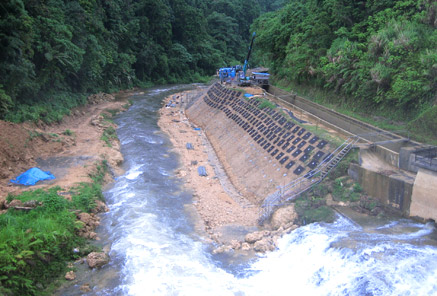Vanuatu
Geography
Land Use
People
Economy
Water Statistics
|

Status of Water Resources
In Vanuatu, both ground and surface water are used for domestic purposes. In urban areas the main water source is shallow aquifers whereas in rural areas various sources are used such as bores, wells, springs, rivers and rainwater catchments.
Urban water supplies are provided by UNELCO (a private company) in Port Vila and Public Works in Luganville, Isangel and Lakatoro. All rural supplies are donor-funded and designed and delivered by either the drilling section or rural water supply (within DGMWR). Rural water supplies are operated and managed by the local community.
Problems with Water Resources and Associated Environment Issues
- Demands and competing uses of water
Where water extraction is monitored because it is provided as a reticulated supply, then there is some knowledge and observation of the aquifer. In both Port Vila and Luganville aquifers are under increasing pressure from housing, agriculture and other developments. Outside of the demands of the reticulated supply, no formal assessment has been made of demand or impacts of competing use.
- Groundwater quality and quantity
Information on ground water in Vanuatu is sporadic and mostly focused on Port Vila and Luganville. Groundwater quality in both urban centres of Port Vila and Luganville is generally good with only calcium hardness to note. Neither water supply currently requires treatment other than chlorination. However, in both cases aquifer levels are thought to be decreasing while pumping demands are increasing.
- Surface water quality and quantity
Information on ground water in Vanuatu is sporadic and mostly focused on Port Vila and Luganville. Groundwater quality in both urban centres of Port Vila and Luganville is generally good with only calcium hardness to note. Neither water supply currently requires treatment other than chlorination. However, in both cases aquifer levels are thought to be decreasing while pumping demands are increasing.
- Pollution
Scabies, skin diseases and malaria are water related diseases and are the three most common health issues in Vanuatu. Poor drainage and waste management provide pools of water that are favourable breeding sites for malaria mosquito. Unmanaged and uncontrolled sanitation and wastewater are also major concerns.
Diagnostic Report
Hot Spot Analysis
Information on this page obtained from Integrated Water Resources Management programme's Diagnostic Reports (SOPAC 2007)
Information on this page obtained from Integrated Water Resources Management programme's Diagnostic Reports (SOPAC 2007)
















